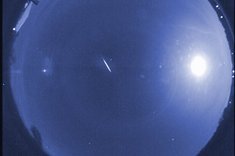The famous Leonid meteor shower is predicted to reach its peak in the predawn hours on Friday (Nov. 17). Weather permitting, observing conditions will be perfect: There’s a new moon on Saturday, which means that the sky will be dark with no hindrance whatsoever from moonlight.
But don’t expect to see a lot of meteors. In fact, a single observer will likely see no more than 10 to 15 of these meteors per hour emanating from the “sickle” of Leo, the lion .
Hence the moniker for these meteors: the “Leonids.” The sickle — a star pattern that looks like a backward question mark and outlines the “mane” of Leo the lion — rises above the east-northeast horizon around 11 p.m. local time. By about 5 a.m. local time, this eye-catching star pattern will have ascended to a position high in the south-southeast part of the sky. [Most Amazing Leonid Meteor Shower Photos ]
Leonid meteors will appear to emanate from the constellation Leo. To see the meteor shower during its peak, look east in the predawn sky on Friday (Nov. 17).
Credit: NASA
The Leonid meteor shower is an extremely variable event that happens every year when Earth’s orbit crosses a trail of comet crumbs left behind by Comet Tempel-Tuttle. A dense swarm of Leonid meteors returns to Earth about every 33 years, or about the time it takes for Tempel-Tuttle to orbit the sun.
Accompanying the return of its parent comet, the Leonid meteor shower arrives as a storm of meteors every 33 years, producing more than 1,000 “shooting stars” per hour. (During the strongest outbursts in 1799, 1833, 1866 and 1966, spectacular displays exceeded 1,000 meteors per minute!)
During the most recent Leonid cycle, however, meteor rates were much lower. Between 1998 and 2002, meteors fell at the rate of many hundreds to several thousand per hour.
In 2014, the swarm of Leonid meteors was at aphelion — the point in its orbit farthest away from the sun — out near the orbit of Uranus . That’s the main reason the Leonids have been weak in recent years. But they are always somewhat unpredictable.
Earth meets these meteors head-on because they are traveling through space in a direction opposite to that of our home planet. As a result, they streak through our sky at ultraswift speeds of up to 45 miles per second (72 kilometers per second). About half of them leave visible trains that, in the most extreme cases, can persist for many seconds.

0 of 10 questions complete
An unfortunate circumstance will befall the Leonids in the year 2028. On its way in toward the sun, the swarm will pass near Jupiter, and the big planet’s powerful gravity will deflect the thickly clustered trails of meteoroids away from Earth’s orbit. As such, potential major Leonid displays in 2031, 2032 and 2033 either will be considerably reduced in intensity or might not materialize at all. [How Meteor Showers Work (Infographic) ]
However, Jupiter apparently will have little or no influence on the Leonid swarm in 2034, and most meteor experts believe that as many as 500 to 1,000 meteors will appear per hour. That’s a far cry from the stupendous storms that occurred in the 18th, 19th and 20th centuries, yet there will still be a plentiful number for those gazing skyward 17 years from now.
But in the interim, check out the Leonids this weekend. If you’re going out to watch for meteors, try to find dark skies away from light pollution, and remember to bundle up — it can get chilly at night this time of year even in warmer climates! Good luck!
Joe Rao serves as an instructor and guest lecturer at New York’s Hayden Planetarium. He writes about astronomy for Natural History magazine, the Farmer’s Almanac and other publications, and he is also an on-camera meteorologist for Verizon Fios1 News, based in Rye Brook, New York. Follow us @Spacedotcom , Facebook and Google+ . Original article on Space.com .

Comments are closed.